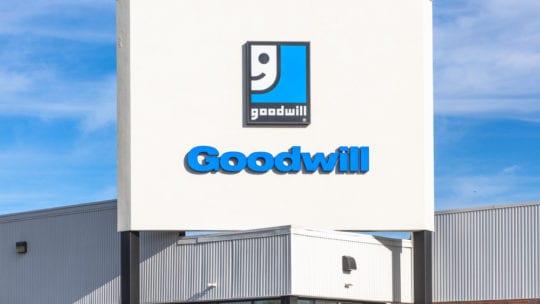
With the FTC recently issuing a step-by-step guide on what it means to be a "good" influencer, we are reminded that smart influencer communications remain a vital part of any sound media relations strategy.
To further examine how influencer communications feed into media relations, PRNEWS is hosting the "Working with Influencers and Brand Ambassadors for Maximum Impact" session on day two of our 2019 Media Relations Conference, going down Dec. 12-13 at Washington, D.C.'s Georgetown Marriott. The session will feature Lina Renzina, talent relationships and partnerships manager at Ad Council, co-presenting with Lauren Lawson-Zilai, senior director of PR at Goodwill Industries International.
Ahead of her session, we asked Lawson-Zilai to talk about how Goodwill Industries International scaled its influencer program to empower members of its local community nonprofits to recruit area influencers, setting a model for how other small nonprofits can activate influencers and brand ambassadors in the process.

PRNEWS: Though you are an international nonprofit, your work often gets hyperlocal. How did building out an influencer program allow you to interface with local Goodwill community nonprofits?
Lauren Lawson-Zilai: We keep a pulse on how the industry is changing, so it’s been a model for our Goodwills in terms of how they can look at different opportunities for engagement and awareness. We’ve started consultations with our local counterparts and implemented a model that they can replicate. We’ve given them talking points, taught them the difference between brand ambassadors and influencers, how to work with influencers on incentives, how influencer relationships benefit their social media channels, and how to measure impact.
We [also] put together a template contract that they can then use with their local influencer relationships. The contract is our standard contract, but our legal team has revised it in a way that serves as a template.
That’s always the biggest challenge—our members want to get started, but they need pointers on how to go about contacting someone, researching someone, and what the levels of engagement are.
PRN: You’re providing them with a real starter’s kit. Smaller nonprofits should note that this is scalable, influencer relations. There’s an assumption of what resources or buy-in a smaller organization must have to get started on an influencer program.
LLZ: That’s essentially how we function and implement a lot of our campaigns. So if it’s our seasonal campaigns like Halloween, or an awareness month like National Disability Employment Awareness Month, we’re arming [members] with the tools they need, such as a letter to the editor, voiced radio spots, social media messaging, etc. We provide that with a 3-6 month lead time so they have enough time to integrate into the plans for their markets.
The same thing goes for influencer relationships. The advantage that members have is, they’re operating stores in their markets, so they have even more opportunity to work with influencers on events such as fashion shows, galas, hiring fairs, etc. My office, the international office, is servicing the members but we’re not putting on events that are generating public attention. So there’s a real opportunity on the local, grassroots level to invite influencers in to take a tour and then to really work with the community.
A few years ago, people would invite in a talk show host—now you’re looking at a social media influencer who is influential in the community and can really generate awareness among targeted demographics, whether it’s Gen Z or moms.
There’s that grey area where I may have someone in New York, for instance, who has high engagement. Recently, we worked with two influencers —a Buzzfeed writer with a hearing disability did a video for us in sign language, and another fashion influencer based in New York we used for National Thrift Shop Day. We learned that one of the influencers – who was New York based – was already working with the local New York Goodwill, so we collaborated on different content to benefit both the local and national channels.
When we are working with influencers, we keep our members in mind because we want them to share this content. Right now, we’re working with Jamé Jackson, a fashion and style beauty journalist, who did the sign language video. She’s doing a whole piece about fashion trends and style during the holidays – how to style yourself for the airport, events, family dinners, etc.
In order to maximize the content, we’ll alert our members through listservs, emails, phone calls and other means, then they’ll re-share the content on their channels. That’s an additional benefit because we have 157 hyperlocal Goodwill 501(c)(3) organizations that have their own Instagram channels as well as other social channels posting that content, and enhancing the shares and engagement.
PRN: How does Goodwill think about influencer autonomy—when is it time to trust their vision and when is it time to be specific in your directions?
LLZ: It’s important not to go about a relationship in a transactional sort of way. Influencers and brands both want the content to succeed. The most successful campaigns are the ones that are as collaborative as possible. Sometimes, a company has to trust the influencer’s knowledge of their audience. It’s about listening to both sides to make sure your goals are met, but the influencer can maintain their authenticity.
PRN: What’s the most important thing to include in a contract around terms of post/timing of posts/duration of posts?
LLZ: Focus on a long-term relationship. Ensure the influencer includes a link back to your product launch, initiative or call-to-action in their bio for a week; and ask that they do not delete content or endorse other competitors, like-minded organizations or causes during the duration of your campaign.
PRN: And what are some of the things you expect from them to report back?
LLZ: Given the change recently with people no longer being able to see likes on Instagram, it’s important that influencers send a screenshot of the backend of their reports, versus sending numbers in an email when you (the client) can’t view it. We also ask influencers to post content that is both stories and a static post. We see the trend toward stories but recognize the importance of a static post to complement that as well.
We pay our influencers at the onset of the contract and then again - once we receive the final reporting.
